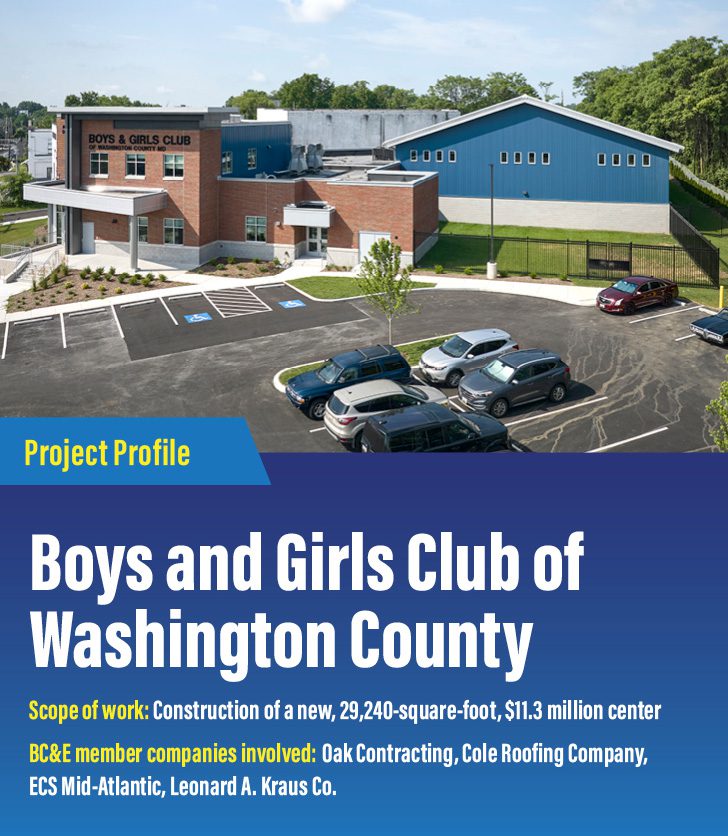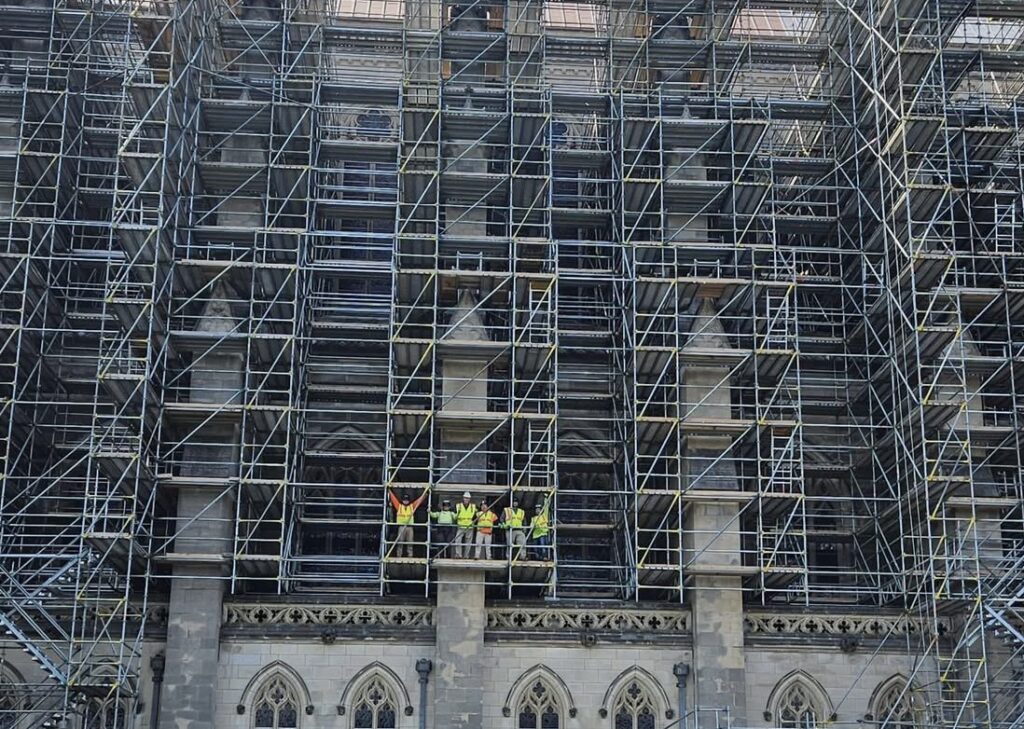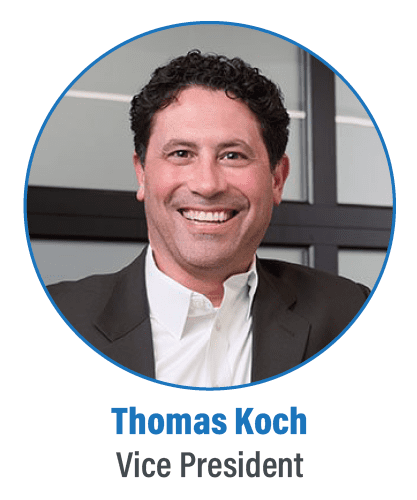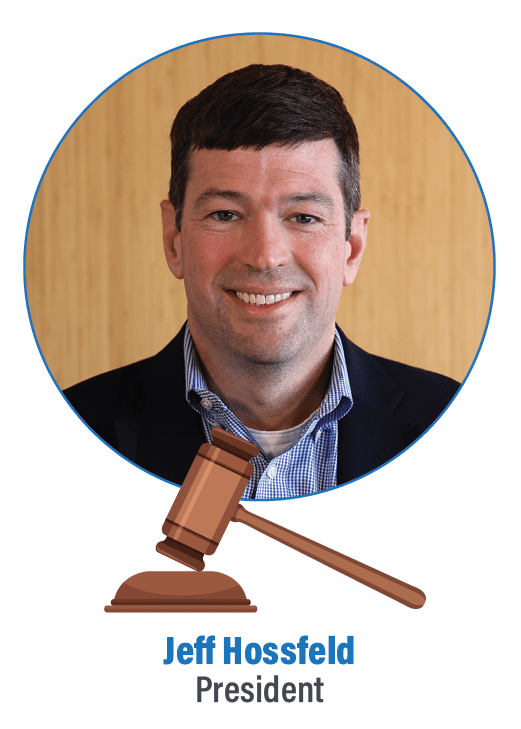Working in style: Employers look to create unique offices
In an old, industrial stretch of Frederick, Engage USA embanked on a unique construction project.
Located in a nondescript and aging building, the database management company wanted to renovate its space to support more efficient workflow, activate some underutilized space, show its corporate culture and create visual impact.
Collaborating with the design team, Petrie Construction reconfigured the floor plan to create a more desirable array of offices, cubicles, conference rooms and huddle spaces. It opened up the front area to create a distinctive lobby/lounge/workspace that exuded company culture.

“We exposed some of the building’s original beams and masonry work to show some of the old architecture that flows through downtown Frederick and to show some of the imperfections and age of that building,” said Matthew Cornelius, Senior Project Manager at Petrie.
The redesign broke with the convention that an office is “a 14 by 10 manilla-colored box with an acoustical ceiling,” Cornelius said. “This client wanted to go beyond cookie cutter ideas and it was exciting to tackle a project where we got to do some eclectic things.”
Those eclectic features extended to the building’s exterior where Petrie erected a custom solar screen. The stand-alone steel structure, which stretched across the entire front façade, was designed both to limit solar gain inside the facility and to make the building highly recognizable.
“I have never had a client ask to erect a steel structure like that before,” Cornelius said. “It is a couple of metric tons of structural steel with corrugated, perforated panels adorning the structure. For anybody who is interested in architecture, it almost makes you snap your neck.”
More budgets for office projects
In Maryland and throughout the country, the office construction and fitout market has been slow since the beginning of the pandemic. Now, gradually, employers are starting to invest in office upgrade projects again. And some of those projects are extraordinary. Completing ambitious and distinctive designs, however, is challenging project teams to deliver exquisite craftsmanship, navigate supply chain challenges, and seek out options to contain costs.
“We’re starting to see more office interior projects,” said Scott Albright, Senior Vice President of MacKenzie Contracting Company. “Some companies have had improvement money in their budgets that they haven’t spent for the past couple of years, maybe because they were unsure of what was going to happen with their offices. Also, a lot of landlords don’t want to see people leave their buildings, so some are offering more tenant improvement money.”

MacKenzie Contracting recently completed the award-winning development of Howard Hughes Holdings’ Maryland regional office. The 14,000-square-foot renovation within a building in Columbia’s Merriweather District created a variety of modern workspaces, gathering spaces and a full café. Filled with warm colors, high-end finishes and several architectural features, the project required exceptional craftsmanship.
“There’s a conference room with a full, insulated, sliding-glass partition that can be closed for big boardroom meetings or opened up to the reception area to create space for bigger gatherings,” Albright said.
Installing that glass wall perfectly and creating a seamless transition across the floor and beyond the wall was especially challenging.
“We had to skim the entire floor, using a laser level, so that when the glass wall went in place the floor looked exactly the same whether the wall was closed or opened up,” Albright said.
Crews completed an extensive and high-end millwork package, including the installation of a custom product to ensure that a wood wall covering showed “the tiniest bead of brushed aluminum” on exterior corners, he said.
Crews installed elevator lobby tile sourced from Italy, a sophisticated lighting package in hard ceilings, and extensive, custom, acoustical treatments.
After applying a standard spray “so you don’t get echoes from the metal deck, we went back in and did a soundproofing spray on all the open areas,” Albright said. “Howard Hughes wanted a [spray] color that would match some of their other finishes, so we had a custom color created and we sprayed the entire ceiling. It added acoustical value and created a more uniform finish throughout the entire open space.”
Attracting talent with better offices
Although some employers have been consolidating their office space, a growing number of companies are now investing in creating nicer workspaces in order to boost morale, increase productivity and attract talent, Cornelius said.
“I have definitely seen a shift towards making the office more inviting, more engaging and warmer than the Plain Jane beige offices of the past,” he said. “There is an HR element to these projects. They want to make the most of people when they are in the office so there is more collaborative and shared space.”
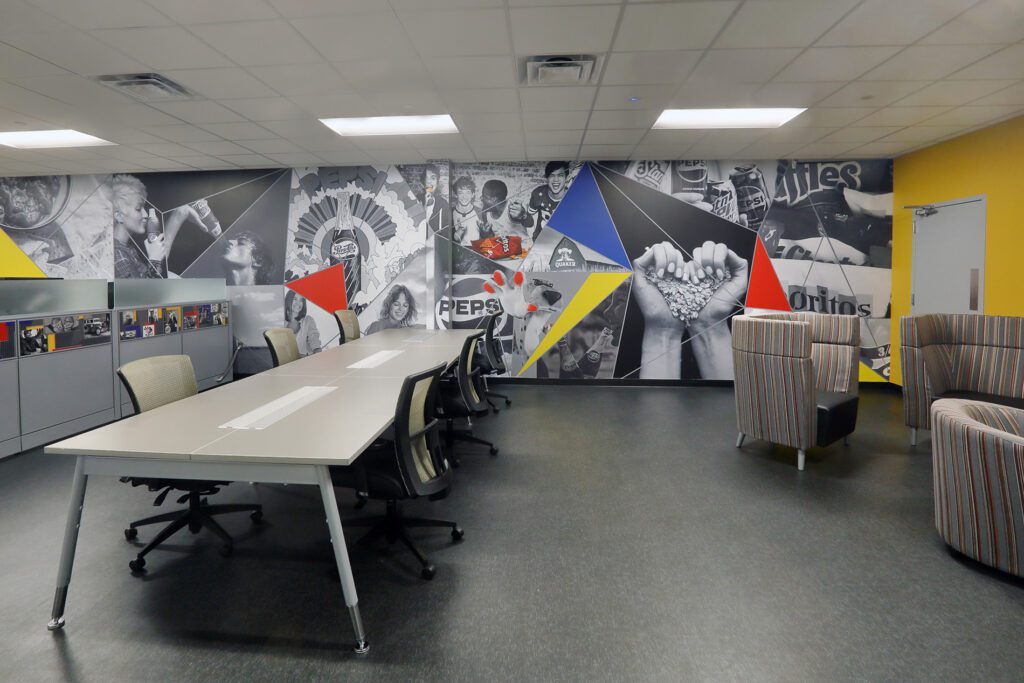
More colorful and comfortable spaces, expanded amenities, unique displays of corporate culture and design elements that are simply fun are included in projects both to please existing workers and attract new ones, he said.
In Aberdeen, Petrie Construction recently completed an expansive, phased renovation of the FritoLay building.
“It was a big push to rejuvenate their office space that was designed to be very brand intensive and create a modern, progressive feel,” Cornelius said.
Bright colors and brand-specific elements dot the redesigned cubicles, collaborative workspaces, break room and other areas.
“They even hired an independent artist to create a mural on one wall of their bullpen,” he said. “From a morale standpoint, it was a huge lift for people who had been working in a dated space.”
In addition to constructing improved offices, some construction companies are creating nicer workspaces for themselves.
In September, Wagman Inc. moved into a new office after completing a gut renovation of a building it constructed for a client in 1994. The new space includes a mix of offices, workstations, hoteling stations, nine conference rooms, a large training room, and informal collaboration zones. Amenities include two kitchen/breakrooms, showers, lockers, a wellness/mother’s room, a fitness center in an adjacent building and a walking path on the property.

“The renovation transformed a dark, outdated building into a bright, modern workspace. We removed every wall,” said Lisa Wagman Glezer, President of Wagman, Inc. “Our previous office was divided across multiple floors, making proximity and collaboration a challenge. The new headquarters offers a cohesive, open layout with exposed ceilings, warm wood finishes, and ambient lighting that balance industrial style with comfort.”
The renovation was also tailored to “reflect Wagman’s identity as a bridge, building and geotechnical contractor,” Wagman Glezer said. “Coordinated colors, finishes and bold wall graphics tell our story throughout the building,” including images of signature projects, floor-to-ceiling graphics highlighting major operations and a “This is Wagman” wall that “celebrates our people on the jobsite, at events and in the community.”
Serving as your own general contractor can certainly streamline a project but doesn’t necessarily make it challenge-free.
Mid-project surprises included “design changes driven by an evolving operational need, coupled with supply chain challenges,” said Ryan Dailey, Senior Project Manager at Wagman. “We worked closely with manufacturers and explored alternative products to keep the project moving forward. Despite the design changes, we were able to stay within budget by finding creative cost-saving solutions.”
Market challenges find solutions in hybrid structures
Faced with desires to create more dramatic architecture, struggles to make multifamily projects pencil out and the need to complete construction projects more quickly, designers and engineers are increasingly embracing hybrid structural systems to address project challenges.
“As markets get more challenging and budgets get tighter, clients want us to be innovative and provide solutions which help deliver their project at a good cost,” said Jack Adams, Sales Representative at Swirnow Building Systems.

That innovation, Adams said, has included using the Hambro structural floor joist system on one common building type — the “five over two” building that typically stacks five stories of wood-framed residential units over two stories of concrete structure. The composite system enables the project design to replace the typical, 16-inch, concrete podium deck with a slender 3.5-inch concrete slab when bearing walls stack with the structure above. Hambro achieves the necessary three-hour fire separation between floors.
Because Hambro is typically a wall-bearing structural system, it can provide large, open spans on the building’s first and second floors. The system can accommodate amenity spaces typically found on the first floor of multifamily, student housing and senior living buildings. Utilizing Hambro at the second, elevated floor level, which is typically living units, eliminates large structural columns that many times hinder the interior design of residential units, Adams said.
The system, he added, aids the viability of projects in several ways. It greatly reduces the weight of concrete dead load which can subsequently reduce the foundation requirements. It also accelerates the construction schedule by eliminating shoring and curing requirements for thick concrete slabs and by closing in the building’s exterior as the structure is erected.
“It’s very common in our mixed-use, multifamily projects to use hybrid structures,” said Steven Anastasio, Vice President and Director of Structures at Bala Consulting Engineers.
While some projects use proprietary systems like Hambro, others “require engineers to introduce other proprietary systems that optimize materials,” he said. “At times, structural engineers become coordinators who pull different systems together and work with fabricators to make sure that everything will piece together effectively.”
For a recent mixed-use building, Bala designed a structure that included a concrete basement to provide below-grade parking, structural steel to provide the open clear spaces needed for planned retail outlets, and five stories of conventional, residential, wood-framed construction.
Such projects challenge designers, engineers and construction teams to balance the different column grids required by parking, retail and residential. Some projects strive to “push the envelope” on what can be achieved with a mix of structural materials, Anastasio said.
And some projects challenge teams to leverage hybrid structures to create “interesting geometries,” he added. “A lot of developers and architects are trying to really dress up their facades, build out cantilevers and insets. Instead of using flat cladding all the way around a building, we are seeing mixes of materials on facades — including brick, wood and metal — that are configured to give façades more dimensionality.”

Some stand-out projects for higher education, institutional and even commercial clients are taking a different approach to hybrid structures to realize their designs. The combination of mass timber and steel is producing structures that provide the sustainability, aesthetics and biophilic aspects of wood with the wider column spans of steel.
In Washington, D.C., Turner Construction Company constructed the gorgeous, light-filled Southwest Library using a mass timber-steel hybrid, incorporating steel elements as part of the lateral force-resisting system.
“We try to use the material that fits best to a specific project,” said Ignacio Fernandez, Senior Structural Design Specialist with Turner.
On the East Coast where mass timber is being used more, that can mean adding steel to the hybrid structure due to the ready access to steelworkers and fabricators in the region.
Designing and constructing a unique hybrid structure, however, presents an array of challenges. Each material has distinct construction and fabrication tolerances, as well as unique responses to changes in moisture conditions.
“Steel and mass timber are good candidates for a hybrid because they have similar construction and fabrication tolerances,” Fernandez said.
One Turner project on the West Coast that combined mass timber with precast concrete, however, required design and construction teams “to accommodate the different characteristics of those materials,” he said. “For example, you have to leave some gaps for the CLT [Cross Laminated Timber] panels to breathe.”
Construction of hybrid structures, he added, also requires a “mixed crew” of craftspeople who understand both structural elements, how they work together and how each component needs to be handled.
“I see more unions doing training for ironworkers to transition to mass timber as we are seeing mass timber get some traction on the East Coast,” Fernandez said.
Hybrid mass timber structures, he added, are also being utilized in new markets, including multifamily and student housing for colleges and universities.
“I see it more in residential buildings where you can get a higher rent per tenant because of the appearance,” he said.
Structural systems and evolving building codes are enabling exposed mass timber to be used in taller buildings — up to 12 stories in some jurisdictions.
Even though a mass timber-steel hybrid structure itself is more expensive than a conventional structure, the design choice delivers other savings that can make projects more attractive.
“Compared to a concrete building, it’s a lighter solution, so you are going to save some money on foundations,” Fernandez said. “You also save on finishes because the mass timber becomes your ceiling.”
Project Profile: Boys and Girls Club of Washington County
Built with a limited budget and a moderate footprint, the Boys and Girls Club of Washington County appears poised to have an outsized impact on its community.
Oak Contracting served as construction manager at risk for the development of the 29,240-square-foot facility in Hagerstown. The project design combined a pre-engineered metal structure which would house the center’s gymnasium, with a steel frame and masonry structure which would house the center’s offices, community spaces, a science and technology laboratory, art studio, gaming room and physical fitness room.
“We don’t see a lot of metal buildings in our projects, but economically that’s what worked for this project,” said David Toth, Vice President of Oak Contracting.
Precisely and efficiently combining those two structures required close coordination among the separate subcontractors who were responsible for both building structures and the foundations.
“The metal building had to sit on top of a masonry wall which was built by a different contractor,” Toth said. “We had to get exact submittals on the pre-engineered building and work off of them so the concrete subcontractor could get all the footings, anchor bolts and everything in the right place.”
The site, which had previously housed the former Boys and Girls Club as well as a gas station and some residences, presented other challenges. Rock and assorted underground structures — gas tanks, house foundations and at least one unidentified structure — were encountered and had to be dealt with. An adjacent and busy rail line restricted activity along one edge of the site and cut off access to the construction site several times a day as long trains rolled through.
The project team also had to adjust plans to contend with supply chain challenges and budget constraints.
“One supply chain issue involved the roof. The material was a white, light-reflective rubber roof that was on back order from the factory,” Toth said. “We discussed options with the owner and decided to go with a black rubber roofing. It was not light-reflective and could change the heat gain, so we had to make sure the insulation on the roof was sufficient and the change in roof material wouldn’t affect any performance requirements of the building systems.”
Oak and the subcontractors helped contain costs by value engineering some aspects of the project, such as the lighting package and flooring options. One subcontractor donated $35,000 back to the client and Oak donated its pre-construction services.
Ultimately, Oak was able to return 80 percent of the project’s contingency funds back to the client.
“We understood the owner’s challenges and I think we were good stewards of their money through the whole process,” Toth said.
The project team also succeeded in delivering important design details, such as the multi-colored paint pattern on the gymnasium walls and integrated metal panels on the facade, said Heath Shultz, Oak’s superintendent on the project. Careful coordination of subcontractors also ensured that crews could work around train blockages, avoid disruptions to the surrounding residential community and complete work on schedule, Shultz said.
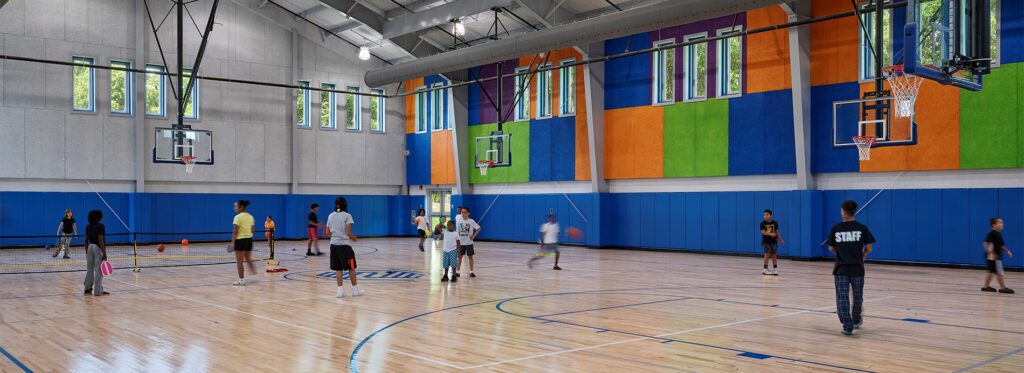
The most impressive aspect of the project, however, was its impact on the community, said Sara Allentoff, Assistant Project Manager.
“We were invited to the ribbon cutting and the love you felt from the community was unreal,” Allentoff said. “We had people come up to us who were members 50 years ago and they still live in the area. They told us the club saved them. It was exciting to see this community get a facility that is so needed.”
BC&E celebrates ribbon cutting of SAFE training center
After six years of work and a litany of construction challenges, BC&E members and residents of southwest Baltimore gathered in September for the official ribbon cutting of the SAFE Workforce Development Center.
A project of the nonprofit Safe Alternative Foundation for Education, the 3,200-square-foot center on South Payson Street includes a carpentry workshop and classroom spaces and will deliver National Center for Construction Education (NCCER) accredited training programs in construction trades. The organization expects to train a minimum of 100 people at the center annually.
“The community is excited about it” said Van Brooks, Founder of the Safe Alternative Foundation for Education. “It truly is one of the most disinvested communities in Baltimore City and certainly in southwest Baltimore. There has been no investment there in the past 10 to 15 years. So, to have someone bring in a facility that is going to bring resources and opportunities, the community loves it.”
The project, he noted, faced innumerable hurdles.
The plan was to create the training center in three vacant Baltimore rowhouses, including one that had been converted into a car wash. The buildings had experienced decay, water damage and renovations that made the proposed project especially challenging. The ground floor of the former carwash had been sloped for drainage and the upper floor raised to accommodate the car bay. Consequently, the floors of the three rowhomes did not align.
“At the very beginning, we had so many people telling us the property was a tear-down and we weren’t going to be able to retrofit it to create what we wanted,” Brooks said.
The BC&E Foundation, however, got involved in the venture and GWWO Architects developed a plan to salvage and transform the space.
“The Foundation is all about creating opportunities for the trades, so Van’s mission and our mission are in direct correlation,” said John Stahl, former president of the BC&E Foundation and Vice President Sales at Swirnow Building Systems. “What our members accomplished with the SAFE Workforce Development Center project is tremendous. The thing I love about our organization is we have members who are committed to the mission and are active doers. They actively put in the effort to make things happen.”
In total, 13 BC&E member companies committed to assist the project: Ariosa & Company, Baltimore Fabrication, Bunting Door & Hardware, Cap Ex Advisory Group, Excell Concrete Construction, GWWO Architects, Henry J. Knott Masonry, James Posey Associates, Leonard A. Kraus Co., MK Consulting Engineers, Swirnow Building Systems, Temp Air Company, and The Whiting-Turner Contracting Company. The companies donated professional and trade services and provided other work at low rates.
“The biggest lesson from the last six years, honestly, is that anything is possible with the right team, the right support,” Brooks said.
The first cohort of carpentry trainees is scheduled to start their studies at the center in November once the final finish work and furniture installation is complete.
Tee-rific turnout raises record funds
Thank you for making the BC&E Foundation Golf Outing a success.
This year’s event brought together 124 golfers for a fun-filled day of friendly competition that raised more than $38,000. The level of play was impressive, complete with a score card play-off to determine who took home top honors with the winning score of 60.
Our “Hit It to Win It” contest returned for a second year and was another success with more than 85 golfers participating throughout the day!
Most importantly, the funds raised from this outing will help us continue our mission to build the construction industry’s future workforce by promoting and supporting education and building programs that are beneficial to the recognition, development and growth of the Greater Baltimore construction industry.
Thank you to our sponsors who helped make this event a success.
It’s Academic: Higher Education projects focus on key goals in competitive market
From the Henrietta Lack Building on Johns Hopkins’ East Baltimore campus to the new Health Professions Building at Towson University to the stunning new dormitories at Morgan State University, higher education clients have been pursuing a wealth of construction projects.
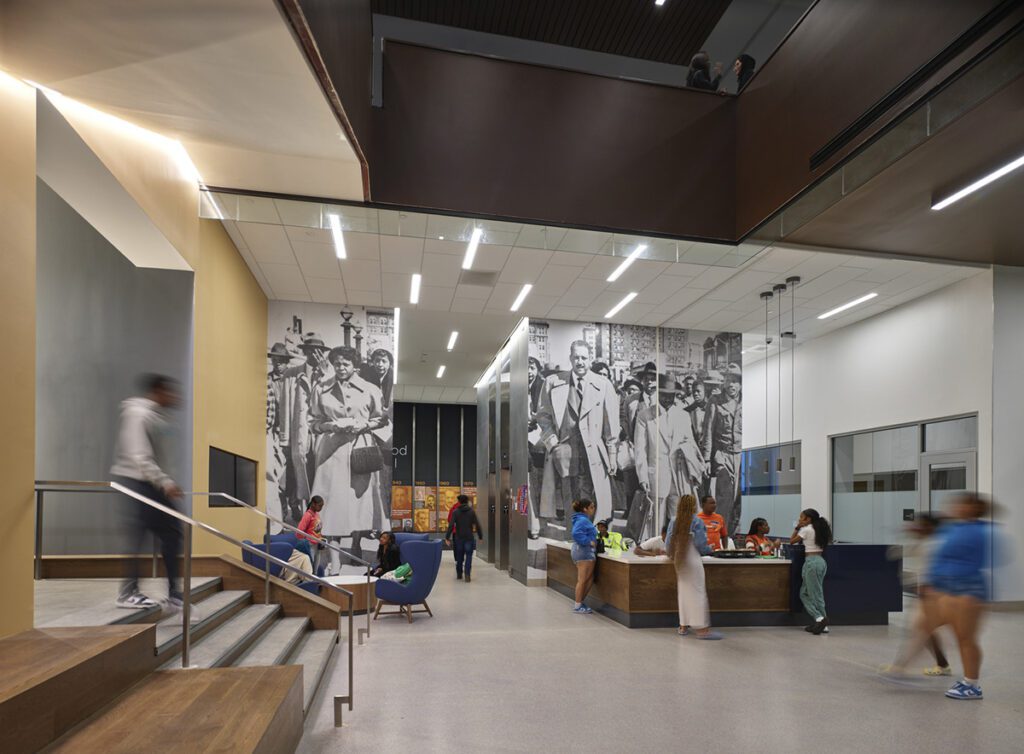
The list goes on to include new STEM research and instructional buildings, athletic facilities, student centers, renovations and repurposing of old buildings, and master plans to upgrade entire campuses.
However, faced with heightened competition to attract students and a tight funding environment, higher ed clients have grown increasingly tactical in selecting their construction investments. They are finetuning project requirements to advance key educational goals, deliver distinctive facilities, and create inviting and flexible spaces that students and faculty take ownership of. The projects also aim to minimize operational challenges in the future.
“There is a recognition that higher ed institutions are in a competitive market because students have a lot of choices,” said Eric Feiss, Principal at GWWO Architects. “Institutions have to demonstrate their value and one way to do that is through facilities that focus on students and the mission of the schools.”
Aesthetics, wellness and high tech
At the Community College of Baltimore County (CCBC) in Essex, GWWO Architects recently completed a project that transformed a 1960s field house into a modern wellness center. More than a routine facilities update, the project met key current goals of higher ed design: It created flexible and outdoor instructional space, improved fitness and wellness facilities, and enhanced common gathering space. It also helped the college with a program accreditation.

“The original building was a large, circular field house with a big, multi-purpose gym that could be used for recreation and competition events,” Feiss said. “The fitness room was never planned into the original building, so it had been shoe-horned into the space.”
That arrangement didn’t provide great or fully accessible fitness facilities. In addition, dance classes which CCBC was working to turn into an accredited program, were relegated to a mezzanine space.
The redesign delivered improved sports and fitness facilities, a dance studio, and an expanded entrance with an inviting common area and a display area for CCBC’s trophies. It also created two outdoor educational areas — one outdoor classroom and one laboratory.
“The outdoor laboratory classroom was a wetlands area that was stormwater management in a traffic island,” Feiss said. “We provided access via a boardwalk and created a platform and seating by the wetlands. Now, students and faculty in sciences, ecology, environmental science can access the wetlands, take samples and teach out in the environment.”

Towson University demonstrated its commitment to students and mission with the completion last year of the new, 240,000-square-foot, Health Professions Building. The facility includes high-tech classrooms and laboratories, large lecture halls and a variety of collaborative learning spaces. To provide hands-on learning in a space that resembles real-world healthcare environments, the building also includes state-of-the-art medical simulation centers and cutting-edge technologies, such as the Virtual Body Lab and immersive artificial reality labs.
“The majority of the top two stories of the building are a mock hospital,” said Robert Fisher, Project Executive at Gilbane Building Company. “You’ve got exam rooms, patient rooms, a simulated ER. There are head walls behind the patient beds and the patients are advanced mannequins so they can do simulations of various medical procedures and exams.”
The building, Fisher added, “is also really beautiful. It has some green roof space. There is garden space on the upper floors where you can go outside. There are nice trees and plantings and patio areas that are really nice. It’s something you don’t typically see in a higher ed facility.”
The building was also designed to bring in a lot of natural light through extensive windows, multiple skylights and atriums, including one that is 110 feet tall.
STEM focus
Expansions, updates and even pioneering projects in STEM education are clearly a trend in higher education construction currently. The focus on technology is also convincing community colleges to expand facilities for technical trades training.
“We see a lot of people and a lot of colleges heading in that direction because the trades are making more money than they ever made before,” said David Hoffman, President of Gipe Associates.

At WorWic Community College on the Eastern Shore, Gipe was part of the team that built a 50,000-square-foot, state-of-the-art Applied Technology center. The new facility includes instructional space for five workforce development programs: Information Technology, Construction and Development, Transportation Technologies, Manufacturing, and Engineering and Technology.
The project incorporated sustainable design elements, including LED lighting, low flow plumbing fixtures, high efficiency boilers and chillers, variable speed pumping, variable flow make-up air systems, energy recovery ventilators, and hydronic ceiling cassettes. The building is expected to receive LEED silver certification.
“It’s a really neat building with big, open tech labs where they have actual trainers and real-life equipment so that people can train on HVAC, solar, geothermal and electrical equipment,” Hoffman said. Due to those labs, “these tech buildings are more engineering intensive, but they are still beautiful buildings.”
Construction challenges
Some plans by higher education clients to create stand-out facilities present builders with distinct challenges. The drive to generate outstanding results in higher ed projects includes heightened requirements for specific products and systems.
“What seems to be constant with these projects is the ever-growing complexity of the lighting systems design and control systems,” said Robert Czyzewski, Project Manager with DEL Electric. “This makes for a great aesthetic outcome but adds tremendously to the lead times and our ability to value engineer solutions for possible product substitution.”
A new library building at Stevenson University included an extensive lighting and lighting controls package. The complexity of the system made it “extremely difficult for our team to coordinate locating and mounting of lighting fixtures while working around and cooperating with the other trades,” Czyzewski said.
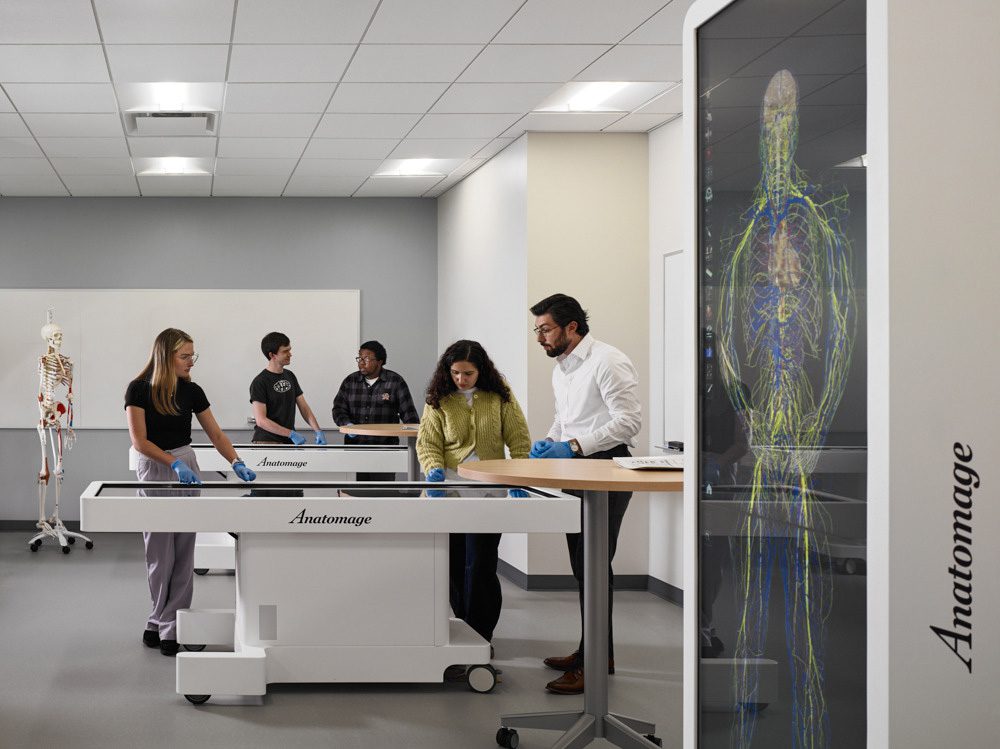
Another project at Stevenson — a black box theatre — included a very complex theatrical lighting and control package that had to be integrated with a separate lighting and control package for the building. Those requirements challenged multiple subcontractors to master new, advanced systems, he said.
On both projects, “the lighting and lighting controls were very challenging for our team,” Czyzewski said. However, “the outcome of these two projects is something you look back on and treasure the experience and the finished aesthetics.”
And nearly all higher education projects challenge builders to deliver projects on a tight and unmovable schedule.
Jonathan Dickinson, Senior Project Executive at Gilbane Building Company, is currently leading construction of his third dormitory at Morgan State University.
“This will total 1,800 beds that we have built for Morgan State in five to six years,” Dickinson said.
The new buildings, he said, are gorgeous, comfortable and supportive educational environments. They include hotel-style finishes, lounges, break-out rooms, fitness rooms and infrastructure to support educational technologies.
But delivering a 600-bed dormitory in about 22 months is no small feat. That has prompted Gilbane to continually refine its procurement strategies.
“We get involved in the project early on, from the concept stage, and create strategies based on lead times of key materials,” Dickinson said.
Those strategies can include completing design documents early and procuring through multiple GMPs.
That approach, Dickinson said, ensures “we always get the dorm done on time, although we always seem to come sliding in headfirst.”
Digging Deep: Old processes and new products conquer subsurface challenges
In a region with expanses of high ground water and little undeveloped land, geotechnical challenges are bound to happen on some construction sites.
As contracting was about to begin on a 14,000-square-foot addition to the Bocek Recreation Center in Baltimore City, a geotechnical report threw a complication into bidders’ calculations. The site had groundwater just six feet below the surface and the project plan placed utilities and foundations well below that elevation.
Furthermore, the report found a layer of uncontrolled fill — construction debris and other rubble — 22 feet down.

The discovery of groundwater just six feet below the surface prompted Plano-Coudon Construction to add a dewatering specialist to its project team. Photo courtesy of Plano-Coudon Construction.
“Anytime you’re doing a new building in Baltimore City, you’re going to run into some type of soil challenge,” said Cliff Milstead, Vice President of Plano-Coudon Construction. “But the last thing you want to do is turn your whole construction site into a muddy swamp. Then it becomes hard to get material and equipment in and out. It becomes hard to do anything and it’s very costly to remove all that mud and bring back stone or better soil.”
The Bocek site challenge convinced Plano-Coudon to add a subcontractor that specialized in dewatering operations to the project team.
“We leaned pretty heavily on them to come up with a design based on the soil classifications and the water level,” said Chris Moody, Project Manager at Plano-Coudon.
That design featured a wellpoint system of small-diameter wells installed around the perimeter of the addition and connected to a header piping system and pump which would discharge the water after passing through a baffled settlement tank. To operate the system, the project team had to bring in a large generator to power the pump and trucks to supply water for the installation of the wellpoints.
“It’s funny to think that you have to bring in water to do dewatering,” Moody said. “But the system used a track punch installation method where they utilize jetted water to assist with the installation of the wellpoints.”
The endeavor included some surprises and uncertainties, including the realization that the team would need to secure a Water Appropriation Permit (a six-month process). Also, the geotechnical report did not determine how quickly the groundwater would recharge so the team couldn’t be exactly sure how long it would take to lower the water level or how much it would cost.

High ground water and undocumented fill increasingly is requiring ECS Mid-Atlantic to stabilize sites through rigid inclusions or other measures. Photo courtesy of ECS Mid-Atlantic.
After a week of 24-hour pumping, however, the groundwater level dropped from six feet to 13 feet and made the site stable enough to support the drill rigs coming in to install auger cast piles, pile caps and other foundation elements for the addition.
A convenience store project saddled ECS Mid-Atlantic with similar challenges.
“We had undocumented, existing fill materials and subsurface conditions included soft, organic, silt materials and a high groundwater condition,” said Chuck Shaw, ECS Mid-Atlantic Group Manager.
For that project, the solution was completing ground improvements through rigid inclusions due to the organic silt materials and a high groundwater condition.
Installing those cementitious columns in the ground “transfers the load of the building through the undocumented fills, through the soft organics and into a more stable layer, and can provide a small amount of densification of the surrounding soils,” Shaw said.
Solving other geotechnical challenges has proven more challenging.
The site of a car wash development in Delaware turned out to have “about 80 feet of dredge materials,” Shaw said. “Rigid inclusions or deep foundations are way too expensive for a car wash, so we are looking at a removal and replacement option. Theoretically, if we remove enough of the dredge material and replace it with lightweight material, so that the building loads and lightweight material are equivalent to the weight of the removed dredge material, this should prevent immediate settlement beyond the typical tolerances allowed for building construction.”
Shaw who is still working out details of a solution for that client, said geotechnical challenges are becoming a more common reality of construction projects.
“All the good sites have already been developed, so often what you are working with are sites where there is some wetland or high groundwater, or redevelopment sites that often have undocumented fill,” he said.
Processes for remedying challenging site conditions haven’t changed much.
“You have heard the term ‘as old as dirt,’ right? That’s what we are dealing with,” said Hasan Aboumatar, Principal Engineer at Froehling & Robertson.
Most solutions still rely on old processes and products, such as localized wells, undercutting, sumps, ground improvements, soil cement, French drains, and under-slab drains.
But some practices and products are evolving.
“Lime treatment to dry out wet soil is common in Virginia, and now I am starting to see it used more often in Maryland,” Aboumatar said.
The industry has also developed better options for dealing with unsuitable soils beneath road and bridge sites.
“If you have soft subgrade when you’re building roads or bridges, we tend to use a lot of Geogrid or fabric,” Aboumatar said. “We limit the undercut to maybe 18 inches or two feet, we utilize the Geogrid, lay stone over it, then sometimes one or two more layers of Geogrid. Now, we have much better Geogrid for these types of applications. Geogrid used to be square so you had strength in two directions. Now, it is hexagonal so you have strength in all directions.”
Technology advances in cone penetrometers and dilatometers are also producing more advanced analysis of subsurface conditions before construction begins, he said.
Project Profile: Washington National Cathedral Restoration
This spring, Scaffold Resource completed the equally robust and delicate operation of erecting a scaffold around the north side of the Washington National Cathedral, including its seven flying buttresses.
“I don’t think there’s a more difficult structure to build scaffolding around than a Gothic cathedral,” said Joe Alonso, Chief Mason, Washington National Cathedral.
The structure was needed to enable ongoing repairs of $40 million in damage the Cathedral suffered during the 2011 earthquake.
“This project required a very, very detailed design,” said Steve Quaerna, Vice President of Business Development and Event Infrastructure for Scaffold Resource.
“Due to the building’s historical significance and preservation requirements, we were unable to anchor or tie the scaffold directly into the structure. This required us to engineer a free-standing scaffold system that provided safe access while protecting the building’s façade and integrity,” Quaerna said.
The Cathedral’s laydown area and operations yard was located directly beneath a section of the north wall where the eight flying buttresses were located, so space was limited, and the scaffold had to be designed to rest on a lower, sloped standing seam roof.
“We had to install a grillage system consisting of aluminum beams and a rubber membrane on the lower roof below the scaffold to disperse the scaffold leg loads so they would not puncture the roof and avoid having to re-shore the roof from the interior,” Quaerna said. “We also had to design the decking to meet very stringent OSHA code requirements and give the workers would proper access to all the parts of that elevation.”
Providing full access was especially complex.
“This is some crazy architecture that you’ve got to work around,” Alonso said.
“There isn’t a building in D.C. that’s more heavily embellished. There are carvings, gargoyles, grotesques. Almost every square inch of that building is hand-carved stone and that style of Gothic architecture has all these slender, flying buttresses with pinnacles and spires.”
OSHA code specifies that workers need to be within 14 inches of the surfaces they are working on, so the scaffold had to place them close to every curved and jutting surface, including the undersides of the flying buttress arches.
The design would also have to facilitate major repair operations, including the use of a crane to remove large sections of stone and equipment to do deep core drilling into the stone to install structural reinforcements.
Erecting the scaffold would also require extreme care.
The earthquake “shook through the walls” of the Cathedral and sent energy “whipping” up through the slender elements, Alonso said. “It was like the cracking of a whip, so all those slender elements — the stones at the top of the finials and pinnacles — experienced a lot of rotations and snapping. The bond in between courses broke and you ended up losing some elements and having a lot of loose pieces of damaged stone.”
The crew erecting the scaffold were the first people to get physically near all of that damaged stonework, so they were under strict orders to not touch anything.
“We have done enough of these repairs to know that you could touch something with your pinky and it would start to sway,” Alonso said.
Installation proceeded without a hitch and even provided the stone masons with early access to the north elevation. By phasing the erection and certification of the structure, Scaffold Resource was able to give stone masons access to the area two months before full scaffold construction was completed.
Rapid Fire Questions
Construction industry professionals are a busy breed, so we asked Board nominees who are on the ballot to re-introduce themselves through a few rapid-fire questions. They succinctly shared their insights on professional best practices, treasured personal activities, nerdy obsessions and super powers they wish they had.
EXECUTIVE COMMITTEE MEMBERS
Thomas Koch
Vice President
The best piece of advice I have ever received is …
Always try to win them over.
My inner nerd gets really excited about …
Modes of transportation: cars, boats, planes, motorcycles, go-karts.
If I could acquire one super power, I would choose …
Teleportation – no traffic, go anywhere in the world, even for a meal, visit everyone.
Marianne Crampton
Treasurer
If BC&E gave out “superlatives,” I would be named “Most likely to ….”
Connect people who didn’t know they needed to meet. I genuinely love helping others build relationships and find support in this community.
The best piece of advice I have ever received is …
“See the best in people.” It’s simple, but it’s carried me through so many parts of my life and career.
My inner nerd gets really excited about …
Hurricane Hunters. I’m fascinated by the technology and the extreme events they help predict and track to help others stay safe.
John Gregg
Secretary
My go-to way to recharge is …
camping in a remote location – off the grid (no phones!)
When it comes to sports, I am best known for …
I’ve been a wrestling coach for 15 years…ask me…I’d be happy to chat with you about wrestling anytime!
If I was a contestant on a cooking show, I would wow the judges with …
an omelette including only ingredients collected from my garden.
Jonathan Goetz
At Large
If I could swap jobs for a day with anyone at my company or at BC&E, I would choose …
Laborer. There is something therapeutic about leaving the headaches in the corner office and picking up a broom and cleaning up a job site.
When it comes to sports, I am best known for …
soccer or triathlons.
If I could acquire one super power, I would choose …
Flying. Do you know how much less stressful it would be to get to and from meetings?
Board Members:
Schyler Bailey
My secret talent, favorite hobby or best party trick is …
a card magic trick I learned in middle school.
My personal work motto is …
to work from home so I can work in the company of my dog.
If I was a contestant on a cooking show, I would wow the judges with …
my pumpkin pie cheesecake. I won best dessert at my work’s last Thanksgiving contest.
Rick Kottke
My secret talent, favorite hobby or best party trick is …
Visiting real world locations where movie scenes were filmed.
The best piece of advice I have ever received is …
You can’t always trust what someone says but you can always trust what someone does. Actions speak louder than words.
If I could acquire one super power, I would choose …
Mind Reader because in business, insight is the real superpower.
Presenting the 2026 Board Nominees…
It’s election season! It’s time to vote in the 2026 Building Congress & Exchange leadership.
Ballots for the BC&E Board and Executive Committee will be sent out electronically later this month and must be returned by Oct. 22. The new board will be introduced at the Annual Meeting on Dec. 3.
The proposed 2026 Executive Committee is comprised of the following members: Jeff Hossfeld of The Whiting-Turner Contracting Company as President; Thomas Koch of Plano-Coudon Construction as Vice President; Marianne Crampton of MK Consulting Engineers as Treasurer, John Gregg of GWWO Inc./Architects as Secretary, and Jonathan Goetz of Oak Contracting as At Large Member. Ted Bowes will serve as Immediate Past President.
Schyler Bailey of Shulman Rogers and Rick Kottke of Harkins Builders will return for another three-year term. Louis Westermeyer of Windsor Electric is nominated to join the Board.
Before you vote, you may want to know a little more about the nominees.
Get to know our newest president:
Jeff Hossfeld
President
You could say that the BC&E is in Jeff Hossfeld’s blood.
“Theodore F. Krug, who was president from 1907 to 1909, was my great-great grandfather,” Hossfeld said. “He was the owner and operator of G. Krug and Sons which is one of the oldest businesses in Baltimore and is the oldest operating ironworks in the United States.”
In addition, Hossfeld’s great great uncle served as treasurer of the Building Exchange and his great grandfather as a director. Both his grandfather and father worked for James Posey and Associates, one of BC&E’s oldest members, and participated in the organization. As such, Hossfeld is the fifth generation of his family to be a BC&E member.
So, it wasn’t surprising that Hossfeld began attending BC&E events early in his career in the mid-2000s.
“I really enjoyed the craftsmanship program and I would always look for opportunities to nominate craftspeople on projects I worked on,” he said.
Over the last 20 years, Hossfeld has seen younger professionals and a more diverse cross-section of people in the industry getting involved. “The Young Professionals Committee as well as the Women Building Baltimore Committee have brought a new energy to the organization and new ways to engage with others in the industry,” he said.
As president, Hossfeld wants to support and expand efforts to connect with even more members of the Baltimore construction industry and related businesses.
Get to know our newest board member:
Louis Westermeyer
Vice President, Director of Estimating Services
Windsor Electric Company
What is one of your industry-specific passions?
I love seeing projects I am involved with coming to reality. Often as an estimator, I am involved in a project from the initial design conception, working through budgets, design VE, and constructability. To see a project start from just an idea or concept to a fully functioning building is a rewarding process.
What is one of your proudest accomplishments?
On the professional side, I started at Windsor Electric Company back in 1998 as a green, first-year apprentice and have worked my way up to become a Vice President and one of the company’s Principals. I am proud to have had the ability to have worked for such a wonderful company for my entire 27 years in the industry and thankful beyond words for all the opportunities it has presented me.
Personally, along with my wife Courtney, who is the Director, VP of Fund Accounting Oversight at T. Rowe Price, we have raised two great boys. Colin is a senior at University of South Carolina majoring in Supply Chain Management & Logistics and Tyler is a freshman at University of Tennessee pursuing a degree as Doctor of Physical Therapy.
What is one interesting aspect of your personal life?
My wife and I have been together since I was a junior, and she was a senior in high school. We love to travel, especially now that our boys are older and we can experience new things together. The four of us traveled to London, Italy and Spain in the last few years, and are planning a trip to the Germany next year.
I love all sports (baseball, golf, football, especially college football), but I am going to be torn between rooting for South Carolina & Tennessee this year!
